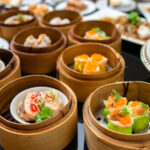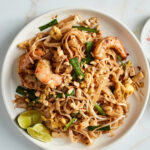Delicious Kimchi is among the most iconic and culturally relevant dishes Korea has for its diet. It has transcended the lowly role as a side dish to become a global phenomenon, crossing several continents with its pungent and sour taste, indicative of bright colors. Kimchi is more than just food; it is about Korea’s past, its culture, and commitment to a healthy diet.
History of Delicious Kimchi
It traces its history back thousands of years to the ancient land of Korea, where fermentation was an essential way of preserving vegetables through long winters. The first version of the dish-plain fermented vegetables, can be traced as far back as the Three Kingdoms Period (37 BC – 7 AD). In fact, this dish altered immensely as it changed in terms of new ingredients being incorporated into its preparation process, especially after the adaptation of red chili peppers through the 16th century, after their entry from the Americas.

Chilies were added to Delicious kimchi, which developed over time into the spicy red vegetable we’re all familiar with. In truth, napa cabbage was likely the most common style of kimchi, although hundreds of variations existed by regional and seasonal differences. Radish kimchi, or kokugi, is, for instance, very different from cucumber kimchi, or oi socage, creating distinctive twists on a common base.
Ingredients and Preparation
The primary ingredients that go into making Delicious kimchi are napa cabbage or daikon radish, garlic, ginger, green onions, and gochutgaru, Korean red pepper flakes. Fish sauce or fermented shrimp are also commonly used for extra depth in flavor but vegetarian versions easily omit these components. Before mixing with the seasoning paste, it is essential that the cabbage is salted down and let wilt since this process draws out the moisture, and in turn, will allow the seasoning mixture to be absorbed into the cabbage.

The limp leaves are then washed and rubbed with a paste made of garlic, ginger, red pepper flakes, and other seasonings. The paste is massaged through every layer of the leaves. Seasoned, kimchi is packed into jars or containers and left to ferment days, weeks, or even months to taste. Its sour tang and umami richness create the flavor profile from fermentation.
The Fermentation Process
The flavor of this product is uniquely obtained by fermentation, which is brought about by the naturally occurring lactic acid bacteria Lactobacillus. They feast upon the sugars in the vegetables as they ferment the food in the salty, anaerobic environment found in a tightly sealed kimchi container, producing the wonderful preservative lactic acid. This fermentation has results not only in a flavorful product but also one that is nutritionally enhanced to stand as a superfood that is full of probiotics.
Flavor profile turns sharper and bolder with longer fermentation times. The fresh-made kimchi tastes crisp, slightly sweet. The aged kimchi develops deeper sourness, making wonderful dishes like kimchi jjigae (stew) or kimchi fried rice or Tacos.
Health Benefits
The other reason why Delicious kimchi is a superfood is its incredible benefits in various health issues. As a fermented product, Delicious kimchi is full of probiotics that improve the gut health by way of balancing the microbiome and easy digestion. Some studies have proved that persons who take fermented foods have a higher immune system, help in maintaining heart health, and reduces inflammatory effects. The food also contains the basic nutrients such as vitamins A, B, and C, and fiber, as well as antioxidants.
The chili peppers contained in Delicious kimchi hold capsaicin, which helps promote metabolism and is an anti-inflammatory agent. Meanwhile, the garlic and ginger have antimicrobial and antiviral benefits, not to mention making kimchi tasteful and a health booster in itself.
Modern Cuisine of Delicious Kimchi
Delicious Kimchi is far from unknown in Korean kitchens, restaurants, and houses, but its fame goes far beyond the Korean borders. The interest in fermented foodstuffs and probiotic diets is developing in the world, and now kimchi appears on virtually every menu around the globe. Creative chefs use kimchi for everything: burger and tacos, pizza and pasta, and introduce popular fans with bold kimchi’s flavor worldwide.

For Koreans, it is beyond being a dish-it’s the soul, and something they produce in large volumes every year in winter on special occasion-that is, while preparing kujang. Even UNESCO has designated it as Intangible Cultural Heritage of Humanity. The critical feature, however, which reflects the significance not only the food but also some sense of Korean identity, is that it is prepared and undertaken communally.
Conclusion
Delicious Kimchi is a true food treasure, loved for its sharp, tangy flavor and trusted for health-giving properties. From being a poor, humble way to preserve vegetables to becoming today’s cultural icon and superfood all over the world, the appeal of Delicious kimchi is undeniable. It serves as a great side dish, fabulous soup condiment, or even a bold addition in modern fusion recipes, making it your favorite among many delectable dishes from around the world. More and more people are discovering the interesting world of fermentation and the probiotic-rich foods of interesting varieties. Meanwhile,Delicious kimchi continues to rise in the ranks, bringing Korean flavors onto tables across the globe.
FAQS
Why is kimchi so delicious?
Tightly packed in an airtight container, the veggies and seasonings are allowed to ferment at room temperature for a few days to a few weeks. The main factors influencing the distinctively tangy flavor of kimchi are the combination of ingredients and the duration of the fermentation process.
What is kimchi sauce made of?
What Constitutes Kimchi? Two napa cabbage heads are the first ingredient in this recipe. In addition to adding taste and prolonging the shelf life, rubbing the cabbage with coarse sea salt removes superfluous moisture. Additionally, you’ll need gochugaru, ground ginger, white sugar, garlic, green and white onions, and fish sauce.
What makes kimchi so delicious?
The flavorful molecules produced by fermentation add to the distinctive punch of kimchi. A study published in the Journal of Agriculture and Food Chemistry found that at least 77 different compounds, ranging from floral and vegetal aromas to buttery cheesy smells and sourness and pungency, contribute to the aroma of kimchi.
What gives kimchi its sour taste?
As it naturally ferments over time, fresh kimchi becomes increasingly sour from its initial salty taste. Therefore, your kimchi will ferment and get more sour the longer you store it. The sour flavor of kimchi is a result of natural fermentation.
Is kimchi spicy hot?
Many people wonder, “Is kimchi spicy?” because of the vivid red hue of gochugaru, the dish’s characteristic flavor. There are several varieties of kimchi that range in spice from moderate to extremely spicy, depending on how much gochugaru was added.



Pingback: Most Delicious Rendang - THE KITCHEN
Pingback: Most Delicious Tacos - THE KITCHEN
I don’t think the title of your article matches the content lol. Just kidding, mainly because I had some doubts after reading the article.